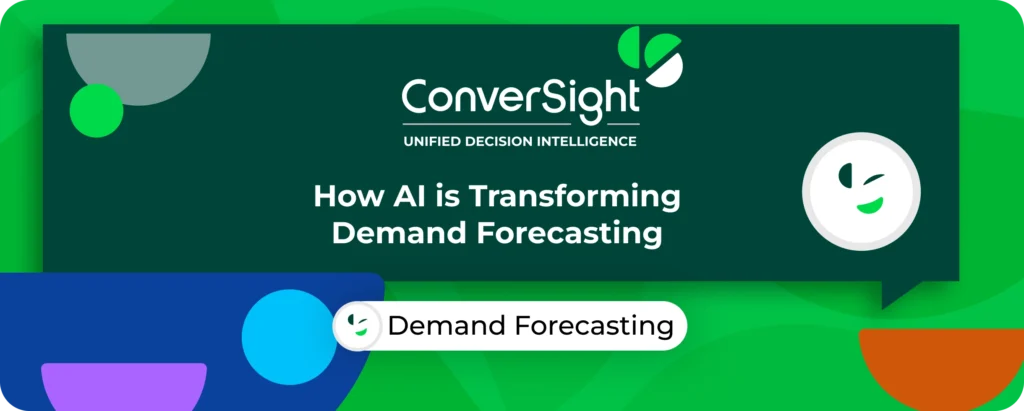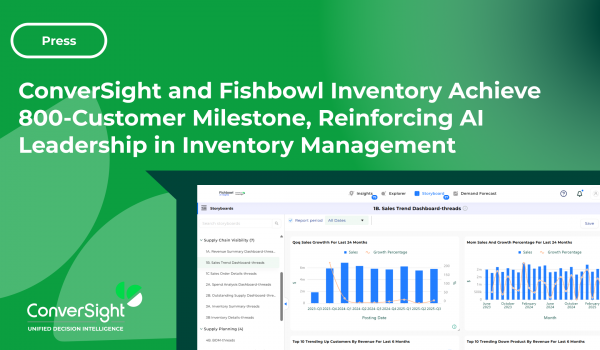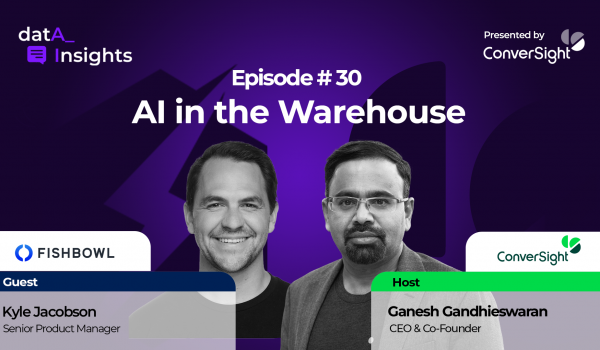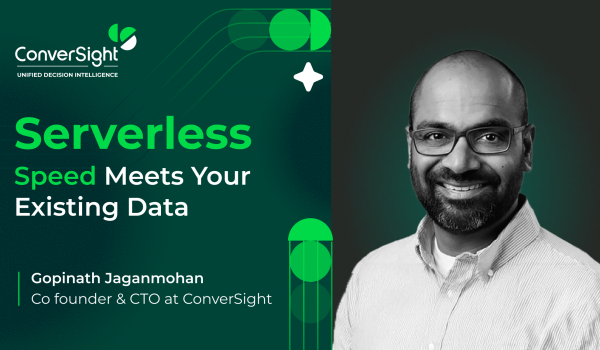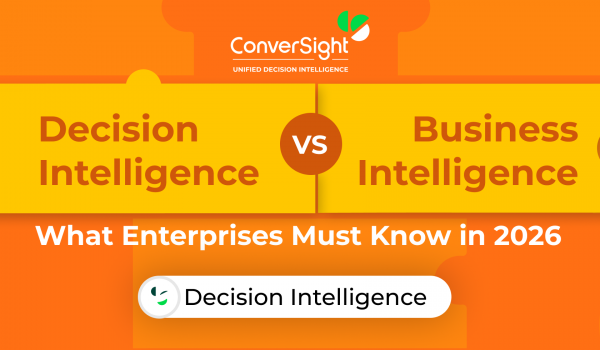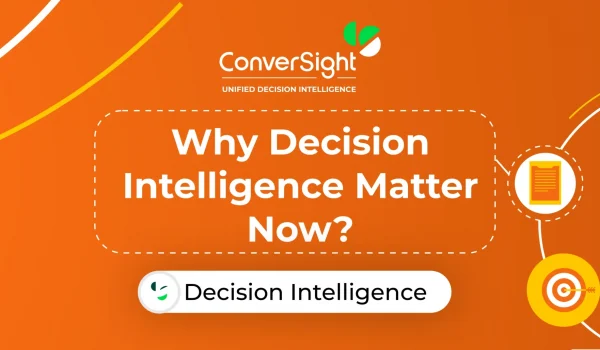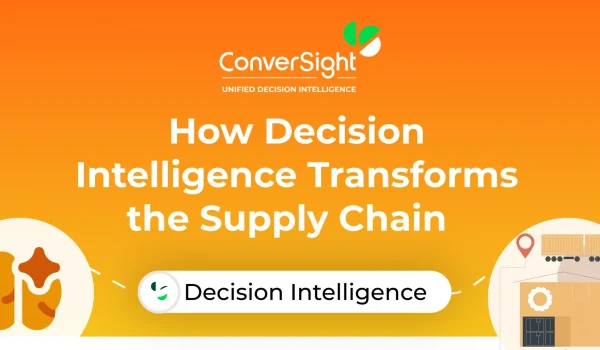Introduction
In an era where business agility is paramount, demand forecasting has become a mission-critical function. But the traditional models that businesses have relied on for decades are now showing their limitations. Static spreadsheets, delayed reports and gut-based forecasting simply can’t keep up with the complexity of today’s global supply chains and volatile market conditions.
This is where Artificial Intelligence (AI) steps in. AI is revolutionizing demand forecasting by enabling organizations to shift from reactive guesswork to proactive planning. With real-time data analysis, machine learning and predictive algorithms, businesses can now anticipate demand shifts, optimize inventory and improve customer satisfaction like never before. This blog explores how AI is transforming demand forecasting, what it means for businesses and how platforms like ConverSight are leading the way.
Understanding Demand Forecasting
What is Demand Forecasting?
Demand forecasting is the process of estimating future customer demand based on historical data, market trends and business intelligence. It plays a vital role in planning production, managing inventory, allocating resources and setting financial goals.
A good forecast aligns supply with anticipated demand, reducing waste, preventing stockouts and ensuring a seamless flow of goods across the value chain. While traditional forecasting methods have served businesses in the past, they often lack the flexibility and depth needed for today’s dynamic environment.
Why Traditional Forecasting Falls Short
Traditional demand forecasting techniques rely heavily on historical data and static models.
Key Limitations of Traditional Forecasting includes,
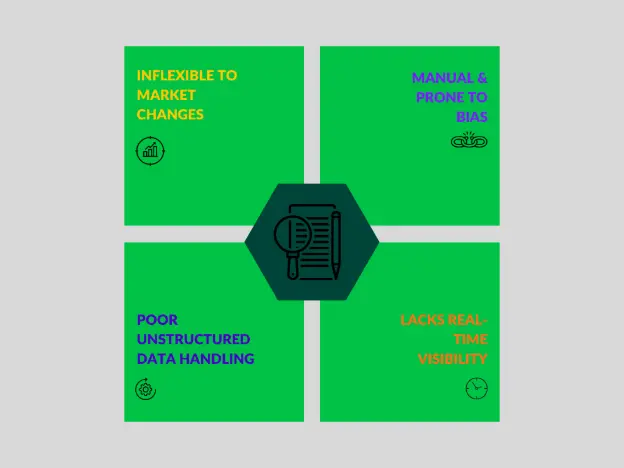
- Inflexible to Market Changes: Traditional forecasting models rely heavily on historical data and predefined patterns. This rigidity makes it difficult to respond quickly to real-time disruptions like unexpected shifts in demand, supply chain bottlenecks, or global events. As a result, businesses are left reacting too late, leading to missed opportunities or excess inventory.
- Manual & Prone to Bias: Conventional forecasting processes often involve spreadsheets and subjective adjustments by planners. These manual inputs introduce inconsistencies and personal judgment, which can skew forecast accuracy. Biases—such as overconfidence or reliance on outdated assumptions—can significantly impair planning effectiveness.
- Lacks Real-Time Visibility: Without real-time data integration, traditional systems fail to capture evolving customer preferences, purchasing patterns, or external market signals. This lag in insight leads to delayed responses and outdated forecasts that don’t reflect the current market reality, resulting in misaligned supply and demand.
- Poor Unstructured Data Handling: Traditional forecasting tools are not equipped to handle the growing influx of unstructured data—from social media trends and customer reviews to weather patterns and economic indicators. This limits the scope of insights and prevents businesses from leveraging valuable external signals that could enhance demand planning.
How AI is Transforming Demand Forecasting
Artificial Intelligence brings a new level of intelligence and agility to demand forecasting by moving beyond static models and manual guesswork. AI-powered systems can process vast volumes of structured and unstructured data—such as historical sales, market trends, customer behavior, weather patterns, and external events—to generate highly accurate and adaptive forecasts.
Unlike traditional methods, AI models continuously learn from new data inputs, enabling real-time updates and more responsive planning. This dynamic approach helps businesses detect shifts in demand early, adjust inventory levels accordingly, and reduce planning errors, minimizes human bias and improves forecast consistency by automating pattern recognition and decision-making. With better visibility and more actionable insights, organizations can optimize production, improve customer service levels, and drive strategic growth.
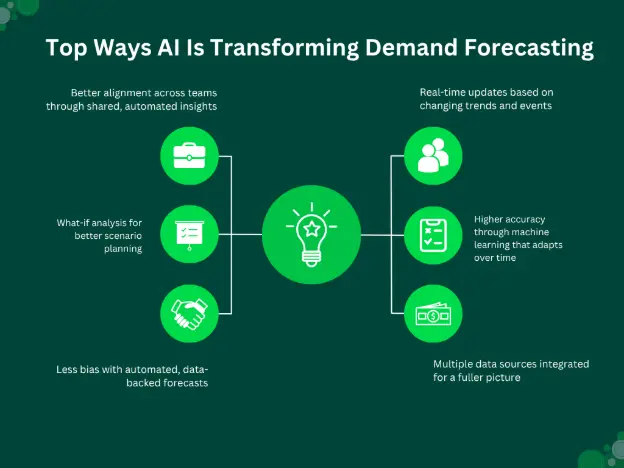
AI Demand Forecasting Software
Evolution of Forecasting Tools
Forecasting tools have come a long way—from simple spreadsheets to rule-based ERP modules and now to AI-powered platforms. Early systems provided basic trend and seasonal analysis. As businesses scaled and data grew more complex, these tools fell short.
The rise of cloud computing, IoT and big data paved the way for AI-based forecasting tools. These modern platforms can process billions of data points, learn from historical patterns and make nuanced predictions with high accuracy. They also support dynamic updates, enabling continuous learning and improvement.
Role of AI and Machine Learning
Artificial Intelligence (AI) and Machine Learning (ML) have transformed the landscape of demand forecasting by making it more intelligent, responsive, and accurate. At the core of this transformation are machine learning algorithms that analyze vast amounts of data to detect patterns, recognize anomalies, and improve forecast precision. Here’s how these algorithms enhance forecasting:
- Dynamic Forecast Adjustments
ML algorithms automatically adjust predictions based on trends, seasonal cycles, and real-time events. This means forecasts are always current and reflective of actual market conditions, rather than outdated assumptions.
- Integration of External Data Sources
AI doesn’t just rely on internal sales or inventory data. It integrates external signals—such as weather forecasts, social media trends, economic indicators, and customer sentiment—providing a richer, context-aware view of demand drivers.
- Anomaly Detection
Advanced models can identify irregularities or unexpected spikes and dips in data. This early detection helps teams investigate and act quickly, whether it’s responding to supply chain disruptions or sudden shifts in customer behavior.
- Continuous Learning and Improvement
One of AI’s greatest strengths is its ability to learn from new data over time. With every new data point, the system becomes smarter refining its models and boosting accuracy without requiring manual intervention.
Real-Time vs Historical Forecasting
While historical data remains important, real-time forecasting is where AI truly excels. By analyzing current data streams—from sales transactions to supply chain updates—AI models can generate immediate insights.
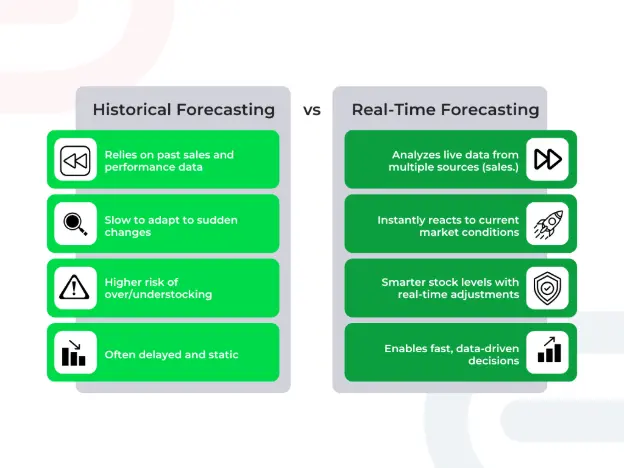
- React to demand fluctuations instantly: With real-time data, organizations can immediately detect changes in customer demand—whether it’s a sudden spike or drop. This instant awareness helps teams make quick decisions to prevent stockouts or overproduction, keeping the supply chain balanced and responsive.
- Adjust production schedules dynamically: Instead of following fixed production plans based on old data, AI forecasting enables companies to shift schedules on the fly. If demand for a product increase unexpectedly, production can be ramped up. If it drops, resources can be reallocated, avoiding waste and excess inventory.
- Optimize distribution and inventory levels: AI provides up-to-date insights into where products are needed most. This ensures that the right quantities are sent to the right locations—reducing excess stock in one region and shortages in another. It also helps streamline warehousing, replenishment, and logistics, cutting costs while improving service.
Core AI Capabilities Powering Forecast Accuracy
Modern AI-powered forecasting platforms are equipped with features that enhance prediction quality and usability. These include:
- Multivariate Time-Series Analysis: Considers multiple variables, such as price changes, promotional campaigns, competitor moves, and economic indicators, to predict demand.
- Natural Language Processing (NLP): Allows users to interact with forecasting models using everyday language, improving accessibility and decision-making.
- Predictive and Prescriptive Analytics: Goes beyond forecasting to suggest actionable next steps based on demand patterns.
- Scenario Simulation: Lets users model different business scenarios to understand their potential impact on demand.
- Anomaly Detection and Alerts: Automatically flags inconsistencies or demand spikes, prompting immediate action.
AI in Sales Forecasting: Predicting Revenue with Precision
Sales forecasting powered by AI leverages advanced algorithms and historical sales data to deliver highly accurate predictions. These systems analyze patterns across multiple channels, customer behaviors, seasonal trends, and external influences (like market conditions or competitor activity).
AI doesn’t just replicate past trends—it adapts to changing dynamics in real-time. For example, if a product begins gaining traction due to a viral social media trend, AI models can detect the spike and adjust forecasts immediately, helping sales teams respond faster and allocate resources more effectively.
By integrating AI into sales forecasting, businesses can:
- Improve revenue planning accuracy
- Align sales and marketing strategies
- Reduce over- or understock scenarios
- Gain clarity on sales team performance and goals
AI in Inventory Planning: Matching Stock to Real Demand
AI also plays a critical role in aligning inventory with predicted demand. By factoring in lead times, supplier reliability, local demand fluctuations, and even weather patterns, AI helps businesses maintain optimal inventory levels.
This prevents excess stock that ties up capital and reduces the risk of stockouts that frustrate customers. As a result, AI-driven inventory planning directly improves operational efficiency, cash flow, and customer satisfaction.
Key Business Benefits of AI Forecasting
AI-powered forecasting delivers benefits across multiple areas of the business:
- Improved Inventory Management: AI reduces both understocking and overstocking by providing highly accurate forecasts at the SKU level.
- Faster Decision-Making: With real-time insights and alerts, business leaders can make quicker and more informed decisions.
- Enhanced Customer Experience: Accurate forecasting ensures better product availability and on-time deliveries, driving customer loyalty.
- Cost Savings: Optimized inventory levels reduce storage costs, spoilage and markdowns.
- Cross-Departmental Alignment: Shared insights create transparency and alignment between sales, operations, finance, and marketing.
AI Forecasting in Action: Industry Applications
AI-powered forecasting is delivering transformative results across multiple industries, tailoring its capabilities to address unique sector-specific challenges:
- Retail: Retailers rely on AI to navigate fluctuating consumer demand, seasonal peaks, and localized shopping behaviors. AI algorithms can factor in promotions, holidays, and even weather data to ensure accurate, granular forecasts. This empowers retailers to avoid stockouts, plan markdown strategies more effectively, and align inventory with fast-moving SKUs at specific locations.
- Manufacturing: In manufacturing, AI enables dynamic demand planning that accounts for raw material lead times, production cycles, and capacity constraints. With predictive analytics, manufacturers can prevent bottlenecks, reduce overproduction, and respond quickly to supply chain disruptions. AI also supports make-to-order and make-to-stock models by fine-tuning forecasts at both finished goods and component levels.
- Distribution and Logistics: Distributors and logistics providers use AI to forecast demand across regions, delivery windows, and customer types. This leads to smarter warehouse planning, improved fleet utilization, and better alignment between inventory availability and customer needs. Real-time demand sensing allows for last-mile optimization and responsive restocking, improving service levels.
- Healthcare and Life Sciences: Hospitals and pharmaceutical companies are adopting AI forecasting to manage fluctuating demand for drugs, medical supplies, and diagnostic services. AI can incorporate external signals such as flu season trends, public health data, and regulatory changes to anticipate demand surges and ensure critical supplies are available.
- CPG (Consumer Packaged Goods): CPG companies deal with thousands of SKUs across fast-moving product categories. AI provides the agility to model consumer behavior, promotional impact, and retailer demand shifts. This reduces stockouts, improves shelf availability, and aligns production with real consumption patterns.
- Automotive: OEMs and aftermarket suppliers leverage AI forecasting to predict part demand across geographies, models, and vehicle lifecycles. AI helps balance just-in-time production with customer expectations while also factoring in EV adoption, regulatory changes, and macroeconomic trends.
Getting Started with AI Demand Forecasting
Embarking on the AI forecasting journey involves more than just adopting new software. Here’s how businesses can set the stage for success:
- Data Preparation: Ensure data quality, consistency, and integration across systems. AI models thrive on structured, high-quality inputs.
- Tech Integration: Connect forecasting platforms with existing ERP, CRM, and inventory management systems for end-to-end visibility.
- Cross-Functional Buy-In: Collaborate across sales, operations, IT, and finance to align expectations and ensure adoption.
- Continuous Monitoring: Regularly evaluate forecast accuracy, model performance, and business outcomes. Use feedback loops to fine-tune processes.
How It’s Easy with ConverSight
ConverSight simplifies and accelerates your journey into AI-powered demand forecasting with pre-built tools, automation, and seamless integration:
- 1-week implementation with minimal IT involvement
- 150+ pre-built data connectors for ERP, CRM, WMS, and more
- QuickStart AI templates built for supply chain, sales, and finance
- AI-powered, not spreadsheet-reliant, eliminating manual errors and delays
- Ready-to-use dashboards that provide immediate insights across department
AI Demand Forecasting with ConverSight
Overview of ConverSight’s Forecasting
ConverSight transforms the way businesses approach demand forecasting by combining the power of AI with a user-friendly, conversational interface. Designed to remove the complexities of traditional forecasting methods, the platform enables any user—regardless of technical background—to interact with data and uncover forward-looking insights effortlessly.
At the core of ConverSight’s approach is its intelligent assistant, Athena, which allows users to ask questions in natural language, such as “What’s the expected demand for next month?” or “How will demand change if prices increase?” and receive accurate, context-aware answers within seconds.These forecasts are not static; they evolve based on real-time inputs, allowing organizations to stay ahead of market fluctuations.
The platform provides:
- Conversational Access: Anyone can engage with the platform using voice or text, making data insights truly democratized.
- Integrated Forecasting: It combines data across systems to provide a comprehensive, unified view of demand.
- Real-Time Demand Sensing: The system picks up on short-term changes and adjusts forecasts dynamically to reflect shifting conditions.
- Visual Dashboards and Alerts: Users can view trends, confidence levels, and anomalies in an intuitive format, with automated alerts ensuring they never miss critical changes.
- Faster, Smarter Planning: ConverSight enables users to plan and respond quickly—whether adjusting inventory, updating supply plans, or re-evaluating strategy—all based on reliable, AI-driven forecasts.
Discover AI-Driven Demand Forecasting with ConverSight.
Real Results from Real Customers
ConverSight has delivered tangible business outcomes across industries by enhancing demand forecasting and streamlining operations. Here are a few success stories that highlight its impact:
- 35% Reduction in Inventory Costs
A wellness food brand leveraged ConverSight to align inventory with real-time demand, cutting excess stock and enabling faster, data-driven decisions.
- 95% Decrease in Report Generation Time
A manufacturing company automated their reporting workflows, dramatically reducing manual effort and improving operational agility.
- 40% Increase in Forecast Accuracy
A leading consumer products company improved forecasting efficiency and cross-team visibility using ConverSight’s conversational AI interface.
Conclusion
AI is no longer the future of demand forecasting—it’s the present. By automating the collection, analysis, and interpretation of data, AI empowers businesses to predict demand with greater confidence and clarity. It removes bias, improves accuracy, and aligns operations with actual market needs.
As volatility becomes the norm, companies that invest in AI forecasting will gain the upper hand—able to pivot quickly, serve customers better, and operate more efficiently. Platforms like ConverSight make this transformation not just possible but practical, combining cutting-edge technology with an intuitive user experience.
See how our AI-powered demand forecasting helps teams plan better and faster – Learn more.
